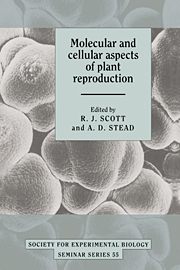Book contents
- Frontmatter
- Contents
- List of Contributors
- Introduction: ‘Where do we go from here?’
- Molecular control of floral organogenesis and plant reproduction in Petunia hybrida
- Control of floral morphogenesis in cauliflower (Brassica oleracea L. var. botrytis): the role of homeotic genes
- Isolation and properties of mutants of Arabidopsis thaliana with reduced sensitivity to short days
- Asexual mutants in Melandrium album (Silene alba): tools in cDNA cloning and analysis of an X/Y chromosome system in plants
- Pollen exine – the sporopollenin enigma and the physics of pattern
- The diversity and regulation of gene expression in the pathway of male gametophyte development
- Characterisation of Arabidopsis thaliana anther-specific gene which shares sequence similarity with β-1,3-glucanases
- Ovule cDNA clones of Petunia hybrida encoding proteins homologous to MAP and shaggy/zeste-white 3 protein kinases
- Towards the elucidation of the mechanisms of pollen tube inhibition during the self-incompatibility response in Papaver rhoeas
- Intracellular movement and pollen physiology: progress and prospects
- Organisation and functions of cell surface molecules on gametes of the brown algae Fucus
- Strategies of flower senescence – a review
- The physiology of petal senescence which is not initiated by ethylene
- Molecular biology of flower senescence in carnation
- Ethylene sensitivity and flower senescence
- Ethylene biosynthetic genes and inter-organ signalling during flower senescence
- Index
Strategies of flower senescence – a review
Published online by Cambridge University Press: 04 August 2010
- Frontmatter
- Contents
- List of Contributors
- Introduction: ‘Where do we go from here?’
- Molecular control of floral organogenesis and plant reproduction in Petunia hybrida
- Control of floral morphogenesis in cauliflower (Brassica oleracea L. var. botrytis): the role of homeotic genes
- Isolation and properties of mutants of Arabidopsis thaliana with reduced sensitivity to short days
- Asexual mutants in Melandrium album (Silene alba): tools in cDNA cloning and analysis of an X/Y chromosome system in plants
- Pollen exine – the sporopollenin enigma and the physics of pattern
- The diversity and regulation of gene expression in the pathway of male gametophyte development
- Characterisation of Arabidopsis thaliana anther-specific gene which shares sequence similarity with β-1,3-glucanases
- Ovule cDNA clones of Petunia hybrida encoding proteins homologous to MAP and shaggy/zeste-white 3 protein kinases
- Towards the elucidation of the mechanisms of pollen tube inhibition during the self-incompatibility response in Papaver rhoeas
- Intracellular movement and pollen physiology: progress and prospects
- Organisation and functions of cell surface molecules on gametes of the brown algae Fucus
- Strategies of flower senescence – a review
- The physiology of petal senescence which is not initiated by ethylene
- Molecular biology of flower senescence in carnation
- Ethylene sensitivity and flower senescence
- Ethylene biosynthetic genes and inter-organ signalling during flower senescence
- Index
Summary
Introduction
Senescence is a process usually considered to encompass those events which lead irreversibly to death. However, whilst the term ‘flower senescence’ is frequently encountered, it rarely relates to the flower as a whole but more particularly to those parts of the flower which are regarded as attractive, that is the perianth parts. In fact, as some parts of the flower senesce, other floral organs are still developing. For example, in species exhibiting protrandy, the anthers may well senesce as the stigma expands and becomes receptive to pollination. A further contrast is to be found when petal and leaf senescence are compared; the degeneration of the chloroplast would normally be regarded as senescence in leaves, however, in petals such a process occurs early on and is considered part of the process of petal development.
The process of flower senescence differs greatly from species to species; in some the petals wilt and may eventually abscise, in others abscission of the perianth occurs whilst fully turgid; in yet others a change in colour of all, part, of the perianth portends the ageing process. From this it is clear that both the physiology and structure of the petals undergo changes during senescence. This review endeavours to describe some of the physiological and structural changes that occur in these varied strategies and the factors, particularly pollination, which may initiate the senescence of the perianth parts.
- Type
- Chapter
- Information
- Molecular and Cellular Aspects of Plant Reproduction , pp. 215 - 238Publisher: Cambridge University PressPrint publication year: 1994
- 22
- Cited by

